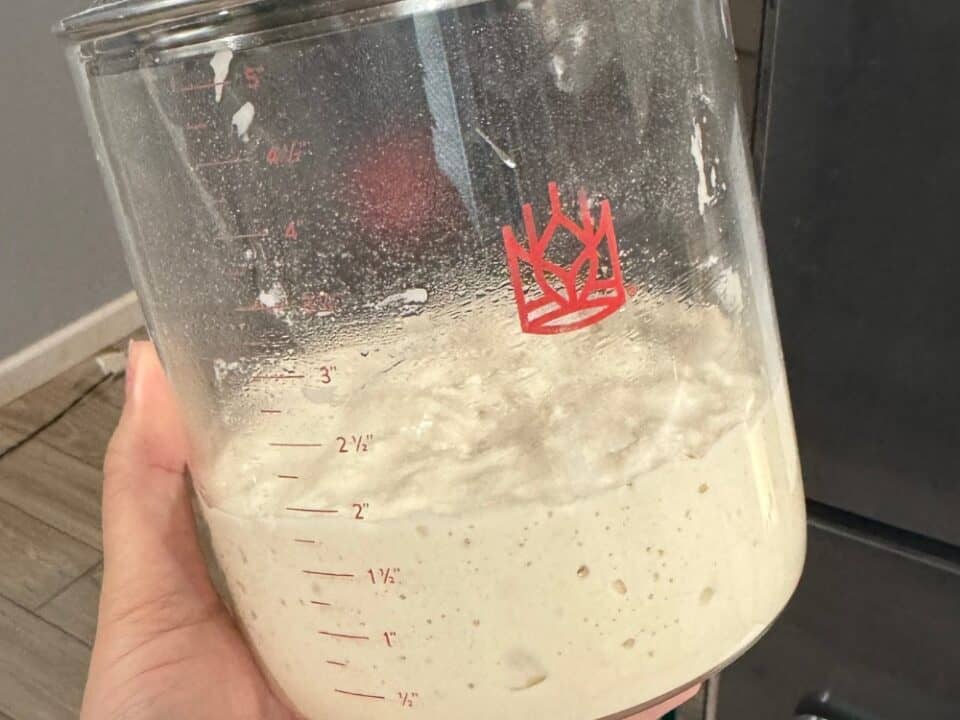10 Common Sourdough Mistakes & How to Fix Them
Sourdough baking is one part skill, one part science, and one part patience. While it’s rewarding, it can also be incredibly frustrating when things don’t turn out the way you want them to. Whether your loaf is too dense, too sour, or refuses to rise, many common issues are caused by simple mistakes. Here’s how to identify and fix the most frequent sourdough mistakes so you can get the perfect bake every time.

This post may contain affiliate links which means we receive a small commission at no cost to you when you make a purchase. As an Amazon Associate, I earn from qualifying purchases.
Using an Inactive Starter
Your sourdough starter is the foundation for everything sourdough. If it isn’t strong enough, your bread won’t rise properly, leading to a dense or gummy loaf. A sluggish starter often happens when it isn’t fed frequently enough, or it has been stored in the fridge for too long without regular feedings.
How to Fix It: Before using your starter in a bake, make sure it’s active. It should double in size within 4 to 6 hours of feeding and have plenty of bubbles. If your starter has been sitting in the fridge for a while, feed it daily at room temperature for a few days before baking. If your starter isn’t rising well, try feeding it twice per day using warm water and feeding it with equal parts flour and water by weight to strengthen it.
Not Measuring Ingredients Properly
Unlike other types of bread, sourdough is all about balance. The ratio of flour, water, salt, and starter determines the final texture. Measuring by volume (cups) instead of weight (grams) can lead to inconsistent hydration, making the dough too dry or too wet.
How to Fix It: Invest in a digital kitchen scale and measure all ingredients by weight. This eliminates the guesswork and makes sure you have the exact right ratios for the perfect loaf. For example, a “cup” of flour can weigh anywhere from 120 to 150 grams depending on how it’s packed, which is a big difference when it comes to sourdough baking. Using a scale means you can troubleshoot problems more easily and get more consistent results.
Underdeveloped Gluten
Gluten development is key to creating an airy and structured loaf. If gluten isn’t properly developed, the dough won’t trap gases from fermentation, leading to dense and heavy bread. This can happen when the dough isn’t kneaded enough or when stretch-and-fold techniques aren’t performed properly.
How to Fix It: Instead of traditional kneading, many sourdough bakers rely on the stretch-and-fold method during bulk fermentation. Perform 3 to 4 sets of stretch-and-folds, spaced 30 to 45 minutes apart. This helps strengthen the dough while maintaining the open crumb structure that sourdough is known for. If your dough still feels weak, consider adding one extra round of folds to build more structure.
Shaping the Dough Incorrectly
Shaping plays a crucial role in how well your sourdough holds its form and rises in the oven. If you don’t create enough surface tension when shaping, the dough can spread out instead of rising upward, resulting in a flatter loaf. Some bakers also handle their dough too roughly, which can deflate air pockets and lead to a dense crumb.
How to Fix It: When shaping, use a gentle but firm hand to create tension on the surface of the dough. To do this, pull the dough taut as you shape it into a round or oval. Let the dough rest for 10-15 minutes after pre-shaping before giving it the final shape. This helps the gluten relax and makes the final shaping easier. A well-shaped dough will hold its structure better and rise more evenly during baking.
Over or Under-Proofing the Dough
Proofing (the fermentation stage after shaping) is one of the trickiest parts of sourdough baking. If the dough doesn’t ferment long enough, it won’t develop enough gas and will bake up dense. But if it ferments too long, the gluten structure will weaken, causing the dough to collapse.
To make it even more complicated, the ambient temperature and humidity in your kitchen play a roll as well. Depending on where you live, you may have to change your proofing times between the seasons. Here in Northwest Florida my times are very different from winter to summer.
How to Fix It: Learn to recognize when your dough is proofed correctly. The poke test is a reliable method—lightly press a wet finger into the dough. If the indentation springs back slowly, it’s ready to bake. If it springs back immediately, it needs more time. If it doesn’t bounce back at all, it’s likely over-proofed (which means it will make a terrific focaccia!). In warm weather, proofing happens faster, so keep an eye on your dough and adjust timing as needed.
Incorrect Oven Temperature
Sourdough baking requires high heat. If the oven temperature is too low, the loaf won’t get a good oven spring (that dramatic rise in the first few minutes of baking). If the temperature fluctuates, your crust might bake unevenly or turn out too pale.
How to Fix It: Always preheat your oven to at least 450°F (232°C) with your Dutch Oven inside and make sure it’s fully heated before putting your dough in. Bake for 25 minutes with the lid on, and then remove the lid to finish baking and get the brown, crispy crust you love. If your bread isn’t browning well, try increasing the temperature by 10-20°F. If your oven has hot spots, rotate the loaf halfway through baking for even browning.
Not Using Enough Steam
Steam is essential for getting a crispy crust and a good rise. Without it, the crust hardens too quickly, preventing the loaf from expanding fully in the oven. This can lead to a dense interior and an overly thick crust.
How to Fix It: If using a Dutch oven, keep the lid on for the first 20-25 minutes of baking to trap steam. If baking on a stone or baking sheet, create steam by placing a pan of hot water on the bottom rack or misting the oven walls with water right before baking. This extra moisture helps the dough expand properly before the crust sets.
Ready to embark on your sourdough journey? Order our Dehydrated Sourdough Starter “Lola” and kickstart your baking journey today!
Cutting the Bread Too Soon
Patience is key with sourdough —even after the baking is done. Cutting into your sourdough too soon can ruin its texture, making the interior seem gummy and undercooked, even if it was baked correctly.
How to Fix It: Let your sourdough loaf cool for at least one hour before slicing. This allows the moisture inside to redistribute and the crumb to fully set. If you cut into it while it’s still warm, the steam trapped inside will escape too quickly, leading to a gummy texture. For the best results, wait until the loaf reaches room temperature before slicing.
Using Too Much or Too Little Water
Hydration levels play a major role in sourdough texture. Too little water results in a tight, dense crumb, while too much makes the dough too sticky to handle, leading to shaping issues.
How to Fix It: Adjust hydration based on the flour you’re using. Whole wheat flour absorbs more water than white flour, so recipes may need tweaking. A good starting hydration level is 70% (grams of water divided by grams of flour). If your dough is too sticky, try reducing hydration slightly. If it feels dry and stiff, increase the water gradually in small increments.
Ignoring Environmental Factors
Temperature and humidity greatly impact how your dough ferments. A recipe that works perfectly in the summer might not work the same in winter because colder temperatures slow fermentation while warmer temperatures speed it up.
How to Fix It: In cooler weather, ferment your dough in a slightly warmer spot, like inside an oven with the light on. In hot weather, proof your dough in a cooler area to slow down fermentation. Adjusting based on your environment will help you get more consistent results year-round.
Final Thoughts
Sourdough baking is a journey of trial and error, but understanding these common mistakes makes it easier to troubleshoot problems and improve your technique. With a little patience and practice, you’ll be able to bake beautiful, delicious sourdough loaves every time. Happy baking!



